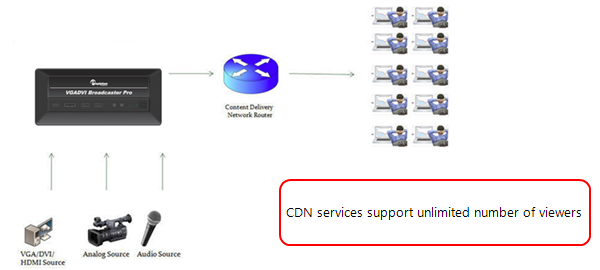Streaming to a CDN and streaming to multiple destinations
A Content Delivery Network (CDN) relies on geo-diverse CDN servers to receive and disperse web content to the CDN server closest to the user. The closer the server is to the user, the faster the content is delivered. Streaming your content through a CDN allows you to stream any time, anywhere, regardless of the viewing device and you don't have to worry about maintaining your own video streaming servers on site.

Unify can publish to multiple destinations at the same time. For more information, see Configure video encoding.
| Publishing Options | Use this option to... |
|---|---|
| Content Distribution Network (CDN) |
Stream web content to many viewers on different Content Delivery Networks simultaneously to any geographical location. Using a CDN to host your broadcast is highly scalable and saves you from having to purchase and maintain your own servers to host and deliver video content. Using one or more CDNs to stream live content allows you to reach a large geographically diverse audience and because CDNs perform format conversion, the stream is platform independent. Streaming protocols supported include: SRT (push), HLS (push), RTMP/RTMPS, . For more information about streaming to a CDN, see Streaming to servers, CDNs, and other devices. |
By default, no streaming is configured for the channels configured on Unify.
Publishing to a CDN
When you publish a stream to a CDN provider, make sure you use a streaming protocol that the CDN supports. Contact your CDN for a list of supported streaming protocols and audio codecs they support.
To publish content to a CDN provider, ensure you have:
- the URL (or path) to the mount point or an XML configuration file (provided by the CDN provider)
- the supported transport protocols, audio codecs, and any other settings like key frame rates and bit rates recommended by the CDN provider
- See Suggested stream settings for the best streaming settings for Unify.
You can control streaming to a CDN using the Admin panel.
For more information see Start and stop streaming to a CDN.
You can also test how your content is streamed by sending your content to Epiphan’s CDN. For a list of Epiphan’s preferred CDN providers, see: https://www.epiphan.com/partners/cdn-partners/.

